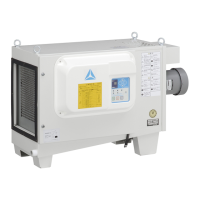Thank you for your purchasing the Amano electrical
collection type mist collector, EM-eⅡ series. It is important
to read the operation manual carefully before using the
dust collector in order to operate it safely and correctly.
lso, make sure to keep the manual close at hand so that
you can refer to it when necessary
.
Important
◎Read thoroughly "1. For Safe Operation" in the page 3 to 7
and use the equipment correctly.
◎ Follow all operation and maintenance instructions and
carry out the daily and periodic inspections as specified in
this manual.
◎Observe all applicable laws and regulations regarding the
installation and maintenance of the dust collector.
◎ This manual is compiled for the model with standard
specifications. In the case that change is made for custom
specifications based on customer's request, the design
and operation style of such model may differ from those
described in this manual.
Name of parts ●
8
Preparation ●
10
Operation ●
17
Maintenance ●
28
Troubleshooting ●
47
Electrical collection type mist collector
EM-e
OPERATION MANUAL
Production date: May 2015
Page
Ⅱ

